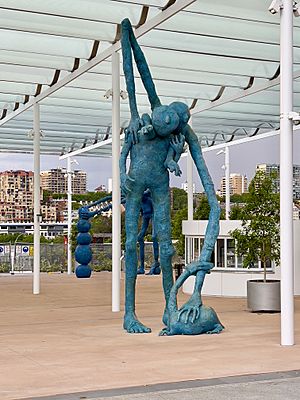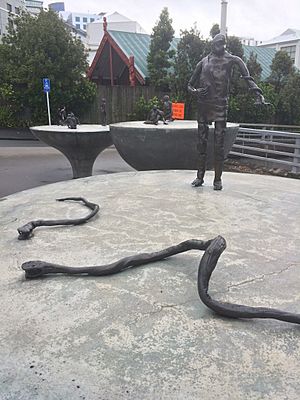Francis Upritchard facts for kids
Quick facts for kids
Francis Upritchard
|
|
|---|---|
| Born | 1976 (age 48–49) New Plymouth, New Zealand
|
| Education | Ilam School of Fine Arts |
| Known for | Sculpture |
| Awards | Walters Prize |
Francis Upritchard (born in 1976) is a famous artist from New Zealand. She lives and works in London. In 2009, she showed her art for New Zealand at a big art show called the Venice Biennale.
Contents
Learning About Art
Francis Upritchard finished her art studies in 1997. She went to the Ilam School of Fine Arts at the University of Canterbury. At first, she wanted to study painting. But in her first year, she became very interested in making sculptures. Soon after she finished school, Francis moved to London.
What Kind of Art Does She Make?
Francis Upritchard makes many different kinds of sculptures.
Early Artworks
Her first artworks often looked like museum displays. They showed collections of old objects and things from ancient cultures. She would mix things she found with her own handmade parts. For example, she made sculpted heads of animals like dogs or monkeys. She put these heads onto old pots or sports gear like hockey sticks.
She also made sculptures that looked like shrunken heads. These were made from plaster and paper mache. They reminded people of mokomokai, which are tattooed shrunken heads made by the Māori in New Zealand. But Francis's heads looked like Pākeha (New Zealanders of European descent) people.
Human Figures in Her Art
Around 2006, Francis started making sculptures of human figures. She said she wanted to explore this more. She saw old wooden figures by an artist named Erasmus Grasser and felt inspired.
Her figures are made from a special kind of clay called polymer clay. She builds them over a wire frame. She paints their skin in many ways, from natural colors to bright patterns. Some figures are naked, while others wear robes and gowns that Francis also makes.
Francis gets ideas for her figures from many places. These include old art like the Bayeux tapestry and Japanese Noh theatre. She also gets ideas from court jesters and medieval performers. People who write about her art often say her figures remind them of hippies or shamans.
Working with Others
Francis often works with her husband, Martino Gamper. He is a furniture designer. He helps her create the stands or bases for her sculptures. These stands can look like tables or even steel pedestals. This shows how much Francis cares about how her art is displayed. She pays close attention to details like fabrics, lamps, and jewelry in her work.
Her Art Career
Bart Wells Institute and First Big Award
In 2001, Francis helped start an art space called the Bart Wells Institute. It was in a warehouse in London. This space held art shows for about two years.
In 2003, Francis was chosen for a special art prize called the Beck's Futures award. She showed an artwork called Save Yourself. It had a small mummy figure that vibrated and made sounds. This artwork helped her become well-known in the art world. A famous art collector, Charles Saatchi, bought her work. This was a big step for her career.
Winning the Walters Prize
In 2005, Francis had her first art show in New Zealand. It was called Doomed, Doomed, All Doomed. This show was nominated for the 2006 Walters Prize, a top art award in New Zealand. Francis won the prize! The judge, Carolyn Christov-Bakargiev, said that Francis's work was amazing to see in person. She felt it was special because it was hard to truly capture in photos.
Showing Art at the Venice Biennale
In 2008, it was announced that Francis would represent New Zealand at the 2009 Venice Biennale. This is a very important international art exhibition.
For the Biennale, Francis created several sculptures. They were shown in an old private house. The show was also called Save Yourself. It featured dreamy or dancing figures on handmade tables, mixed with ceramic lamps. This was the first time she combined figures and furniture in this way. This style has become a key part of her art.
The figures were about 50 centimeters tall. They were made from polymer clay. Some were naked, and others wore handmade cloaks. They were painted in solid colors or patterns, like checkerboards. Francis said she wanted to create a "visionary landscape." She wanted her art to make people think of old painters like Hieronymus Bosch. She also wanted to include ideas from counter-culture movements and futuristic dreams.
The Museum of New Zealand Te Papa Tongarewa bought her artwork Dancers. Other works, Horse Man and Rainwob Tree, are at the Govett-Brewster Art Gallery.
Working with Other Artists
Francis often works with her husband, Martino Gamper, and a jeweler named Karl Fritsch. In 2009, they had an exhibition together called Feierabend. It showed Gamper's furniture, Francis's sculptures, and Fritsch's jewelry.
In 2011, they created a big art project called Gesamtkunsthandwerk. For this, they worked with many other artists from New Zealand. These artists included weavers, potters, and glass blowers. The title means "a total artwork that involves all parts of the arts and handmade work." The artists said they don't believe art, craft, and design should be separate. They feel they all make art with similar care and ideas.
Francis continues to work with others. She recently worked with potter Nicholas Brandon. For her 2016 show Dark Resters, Brandon made ceramic pieces and glazes. These were part of Francis's art installations, along with textiles and her famous figures.
Art in Public Places
Francis Upritchard has also created art for public spaces.
Her first public artwork is in Auckland, New Zealand. It is called Loafers. It has three bowl-shaped concrete bases with her unique human figures on top. There are also several bronze snake shapes. Francis said the bases were inspired by the ceramic artist Lucie Rie.

In 2022, Francis's artwork Here Comes Everybody was shown. It is at the Art Gallery of New South Wales in Sydney, Australia.
Special Art Show: Jealous Saboteurs
In 2016, a big show of Francis Upritchard's art opened. It was called Francis Upritchard: Jealous Saboteurs. This show looked back at her first 20 years of making art. It was shown at the Monash University Museum of Art in Melbourne. Then it moved to City Gallery Wellington in New Zealand.
Art Shows in Public Galleries
Here are some of the places Francis Upritchard's art has been shown:
- 2016 Francis Upritchard: Jealous Saboteurs, Monash University Museum of Art, Melbourne and City Gallery Wellington; Dark Resters, Ilam Campus Gallery, University of Canterbury and Ivan Anthony Gallery Auckland
- 2014 Hammer Projects: Francis Upritchard, Hammer Museum Los Angeles; Whitechapel Gallery Children's Art Commission, Whitechapel Gallery
- 2013 Potato Poem, Marugame Genichiro-Inokuma Museum of Contemporary Art (MIMOCA), Kargawa, Japan
- 2012 Francis Upritchard: A Long Wait, Contemporary Arts Center, Cincinnati; A Hand of Cards, Nottingham Contemporary, Nottingham
- 2011 Echo, Kunsthal KAdE, Amersfoor, the Netherlands; Gesamtkunsthandwerk with Martino Gamper and Karl Fritsch
- 2010 IN DIE HÖHLE, Wiener Secession, Vienna
- 2010 Save Yourself, Museum of New Zealand Te Papa Tongarewa
- 2009 Save Yourself, New Zealand representation at the 53rd Venice Biennale,
- 2008 Rainwob I, Govett-Brewster Art Gallery; Rainwob II, Artspace, Auckland and Gertrude Contemporary Art Spaces, Melbourne
- 2006 The Walters Prize, Auckland Art Gallery
- 2005 Doomed, Doomed, All Doomed, Artspace, Auckland
- 2004 Artist in Residence, Camden Arts Centre
- 2003 Boxing Arms, Dunedin Public Art Gallery


